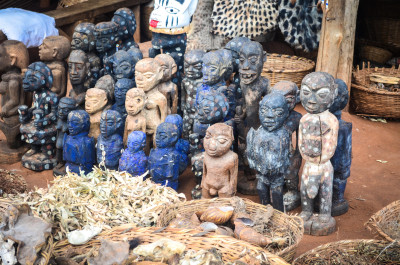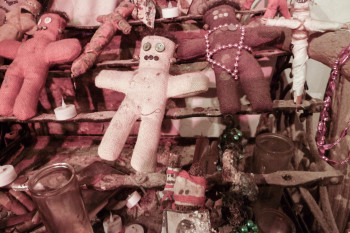The Origin of Voodoo Dolls
While the exact origins of the Voodoo doll aren’t known, it can be tracked down from the Fon people of the region that now Benin. When slavery brought the voodoo religious practice to the Southern United States—specifically Louisiana—it brought along with it the practice of imbuing dolls with magical intent. Many sources say that voodoo dolls are not actually a practice associated with legitimate voodoo, but actual practitioners would disagree. Doll magic is a part of many magical spiritual paths, including European based folk magic, wherein people would create poppets much for the same reasons that are seen in the modern voodoo practice.
Although slaves were forbidden by slave owners to practice voodoo, it was still an extremely common practice. These dolls were frequently used in secret as a means of self-defense, it’s been speculated that this history of trauma is where the dolls originally obtained their reputation for being instruments of revenge. These days it’s not uncommon to see voodoo dolls being marketed specifically for harmful intentions, which contributes to their already dark reputation. It’s unfortunate, as many people are unaware of the common belief that the practice of darker magic ultimately brings around its own darker consequences for the user—depression, conflicts, bad luck, and overall negativity are things that using such methods can bring back. Glossing over details like this are reasons why dark and devious magic practices are often still the source of fright and horror. It wouldn’t look as good to have the main villain of a story worrying about their own comeuppance for using magic that might harm another individual.
During the reign of Marie Laveau, the Queen of Voodoo, the use of Voodoo dolls rose exponentially. Veering from the original practice of carved wooden figures, used to house spirits of those who have passed, the modern-day voodoo doll is typically a small, soft fabric doll used to represent a person who has not passed. Physically, voodoo dolls vary in the extremes, from the type of fabric, color, and pattern, the basic idea is that a hand-constructed doll is a representation of the intended target.
The Importance of Color
Color carries incredible meanings that differ from culture to culture, where love, anger, sadness, infidelity, and more can be expressed merely by the color of an object. Even the culture of flower arrangements had a huge impact on western culture, in which it combined the shades of flowers along with the type of flower being added to the bouquet. Departing from everyday meanings of color, it’s widely believed in many different metaphysical communities that different colors represent different aspects of life and the voodoo community is no exception.
Fabric and Pin Color
When it comes to the actual intention of the Voodoo Doll, one of the most important aspects is the color of the material the doll is made out of, as well as the clothing that the doll is dressed in. The colors with which the doll has been crafted directly correlate to what the doll is meant to be used for. As an example, a doll made of, or clothed in yellow fabric represents things like success, confidence, and attractiveness. Using black fabric for the doll would represent dispelling negative habits, grief, poverty, and bad luck—keeping in mind that a doll made from and fully clothed in black fabric would be used in what is considered “black” magic, which would result in the kind of magic that is often over-represented in television, movies, and books. So what about the pins that you stick in the doll? Well, unbeknownst to many, the color of the pins also holds significance, and the meaning of pin color actually varies more than you might suspect.
How Are They Used?
The concept of these dolls isn’t lost on most people, but the intention of them is frequently confused with how they are portrayed in movies and popular culture—diverse as this spiritual practice is in reality, Hollywood loves to vilify practices that are outside of what is deemed the normal scope of religious practices. This isn’t necessarily meant to be an affront to such practices, the practice of painting it with such broad evil strokes is because of how deeply submerged the actual spiritual practices are in mystery. Modern media portrays voodoo dolls being used by witch doctors, black magic practitioners, and pins that cause pain when placed, but the truth is far more interesting. When exploring this practice in-depth, we see that these dolls are meant to convey the intention of the user, for a full spectrum of uses—not just the dark aspects.

When the user is attempting to manifest their intent, they can use various personal objects for the target. Handwriting samples, locks of hair, a picture or piece of clothing, and even bodily fluids can be pinned to, or stuffed into the doll in an effort to pinpoint the target person—whether that person is alive or dead. To further manifest the doll as a representation of the target, the user may focus upon the intended person during meditation or spells, either by placing it upon their altar or while holding it. Additionally, specific herbs are often stuffed into the dolls and oils are also used to anoint the doll before use.
What is done with voodoo dolls once they have been used for their purpose? The final step when using a voodoo doll is as much of a variable as what the doll is made of. There are a few methods for finalizing, some elect to toss it into a river, or lake if available to them, others bury them in the ground, where still others may burn them. Each of these avenues is a symbolic reference to ending a particular spell—to give the doll up to a rushing river would be helpful in sweeping everything the doll represents away with the moving water; whereas burying would imply wanting a solid result, allowing the doll to disintegrate slowly and over time in the earth that surrounds it. Burning a doll has be the most profoundly symbolic way of disposing of the doll, where it is literally turned to ash and the manifestation is carried away into the air through smoke.
It’s not difficult to understand the illustrious dark connotations that voodoo dolls carry outside of the spiritual practice, as it’s steeped in mystery and misunderstood history.

Georgia-based author and artist, Mary has been a horror aficionado since the mid-2000s. Originally a hobby artist and writer, she found her niche in the horror industry in late 2019 and hasn’t looked back since. Mary’s evolution into a horror expert allowed her to express herself truly for the first time in her life. Now, she prides herself on indulging in the stuff of nightmares.
Mary also moonlights as a content creator across multiple social media platforms—breaking down horror tropes on YouTube, as well as playing horror games and broadcasting live digital art sessions on Twitch.


